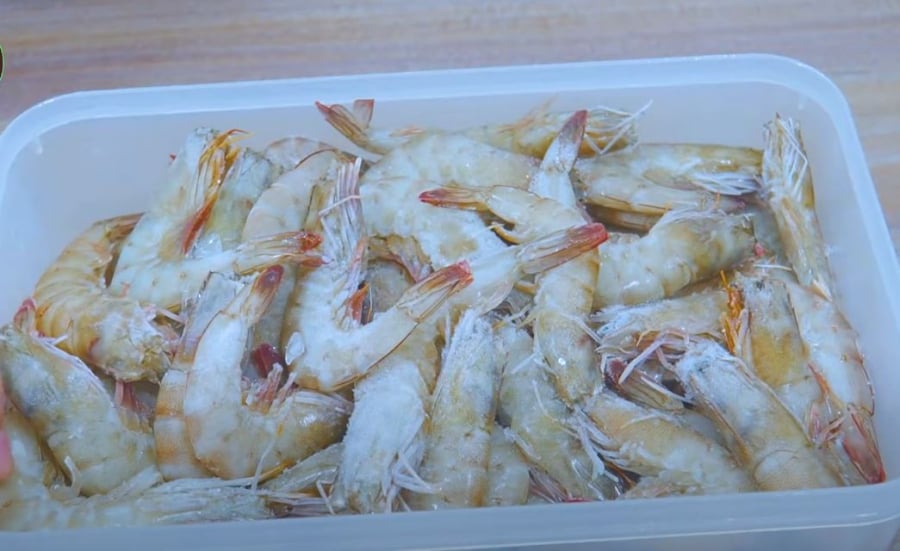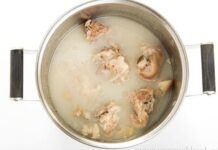Shrimp is a type of seafood that is highly nutritious and can be prepared in a variety of delicious and healthy dishes. Many people nowadays buy a certain amount of shrimp and store it in their refrigerators for later consumption. To preserve the shrimp and maintain its freshness, you can apply the following tips.
How to Store Shrimp
– Store shrimp with beer
Remove the black vein on the shrimp’s back and the waste bag at its head. These parts contain impurities and bacteria. To keep the shrimp fresh for longer, you should get rid of them.
Place the shrimp in a basin and pour beer over them to rinse. Beer contains alcohol, which helps eliminate the shrimp’s fishy odor and prevents bacterial growth.
After rinsing the shrimp with beer, remove them from the basin and use a clean cloth to absorb any remaining liquid. Ensure the shrimp are thoroughly dried to prevent ice buildup, which can cause them to stick together. Arrange the shrimp in a container, seal it tightly, and store it in the freezer or deep freezer. It is advisable to divide the shrimp into portions sufficient for a single meal and store them in separate containers for convenient thawing and cooking.

There are several methods to preserve shrimp.
– Preserve shrimp with sugar
Remove the black vein from the shrimp’s back and the waste bag from the head. Then, rinse them with clean water (or saltwater) and pat them dry.
Arrange the shrimp in a container, sprinkling a thin layer of sugar over each layer of shrimp. Repeat this process until the container is full.
This method of preserving shrimp with sugar helps maintain their freshness for an extended period, preventing them from turning black and losing moisture.
– Use plastic bags or ziplock bags
There is no need to rinse the shrimp; simply allow them to air dry. Divide the shrimp into portions suitable for a single meal. Place each portion into a small bag, remove the air, and seal the bag tightly. Store the bags in the freezer. When needed, take out a bag of shrimp and thaw it.
– Store shrimp with salt
Remove the waste bag from the shrimp’s head and the black vein from its back. Then, place the shrimp in a container, add some salt, cover, and shake well. Store the container in the freezer. This method will keep the shrimp fresh for up to two weeks.
Notes on Storing Shrimp
When you’re ready to cook, transfer the shrimp from the freezer to the refrigerator a few hours beforehand to allow them to thaw gradually, preserving their flavor and minimizing bacterial growth.
If you need to thaw the shrimp quickly, you can run water over them to speed up the process.
Thawed shrimp should be cooked immediately to ensure the best flavor and quality. If you can’t cook them right away, you can soak the shrimp in a basin of cold water with ice to keep them chilled and slow down bacterial growth. However, do not soak them for too long.
The Ultimate Guide to Crispy Fried Shrimp: A Tasty Treat
With this crispy fried shrimp recipe, you’ll create a dish that’s not only delicious but also memorably addictive. The shrimp are coated in a light, crispy batter that fries up golden and crunchy, while the shrimp themselves remain juicy and tender. It’s a perfect balance of textures and flavors that will leave your taste buds craving more.
The Secret to Delicious, Sweet-Smelling, and Non-Fishy Boiled Shrimp: It’s Not Salt and Ginger, but These Two Unexpected Spices.
“Cooking the perfect shrimp may seem simple, but there’s a lot more to it than meets the eye. The secret to achieving that delicate balance between sweetness and freshness lies in the subtle art of seasoning. With the right combination of spices and herbs, you can transform this humble dish into a culinary masterpiece, locking in the shrimp’s natural flavor and leaving your taste buds craving for more.”
The Ultimate Guide to Unlocking the Secrets of Crab and Crayfish Broth: Why Your Choice of Water Matters for a Delicious Dish
Many people wonder why their steamed crab and crayfish often turn out bland, with limbs falling off and a fishy taste that makes for an unpleasant dining experience. Top chefs assert that this is due to the incorrect use of steaming liquid, which plays a pivotal role in determining the outcome of your dish.





































